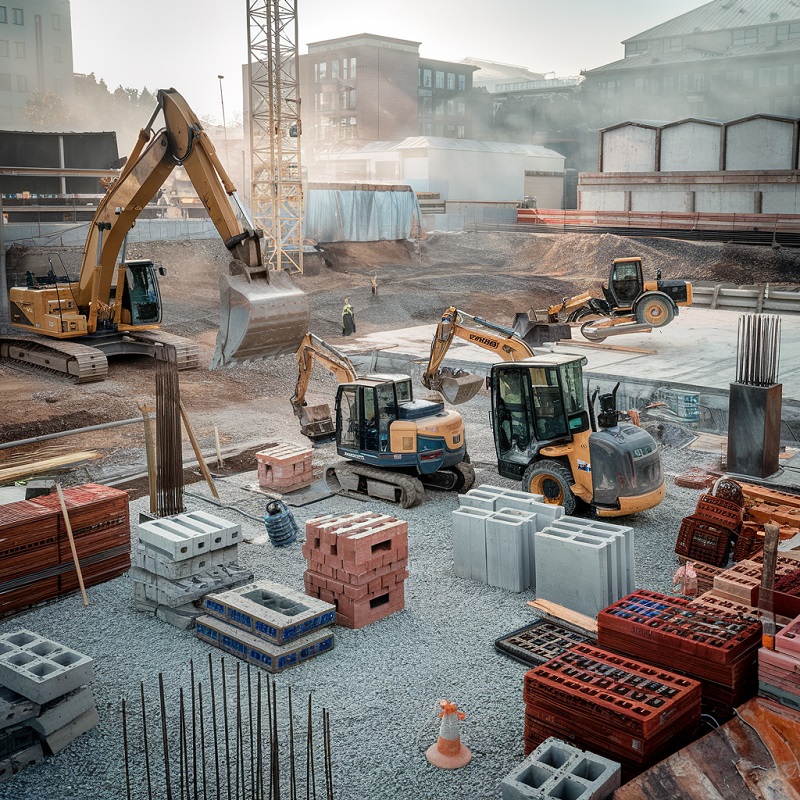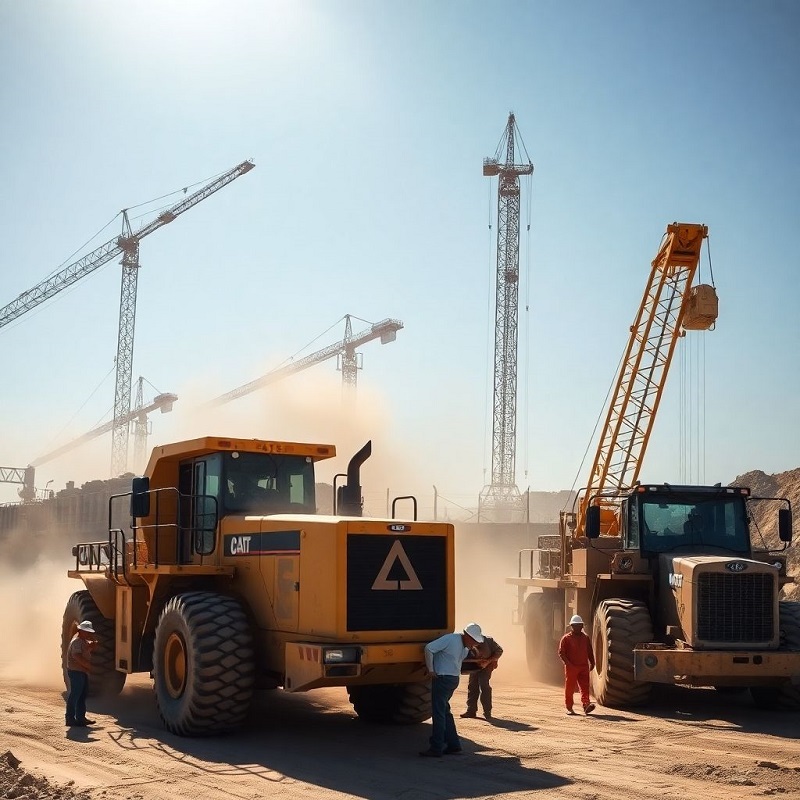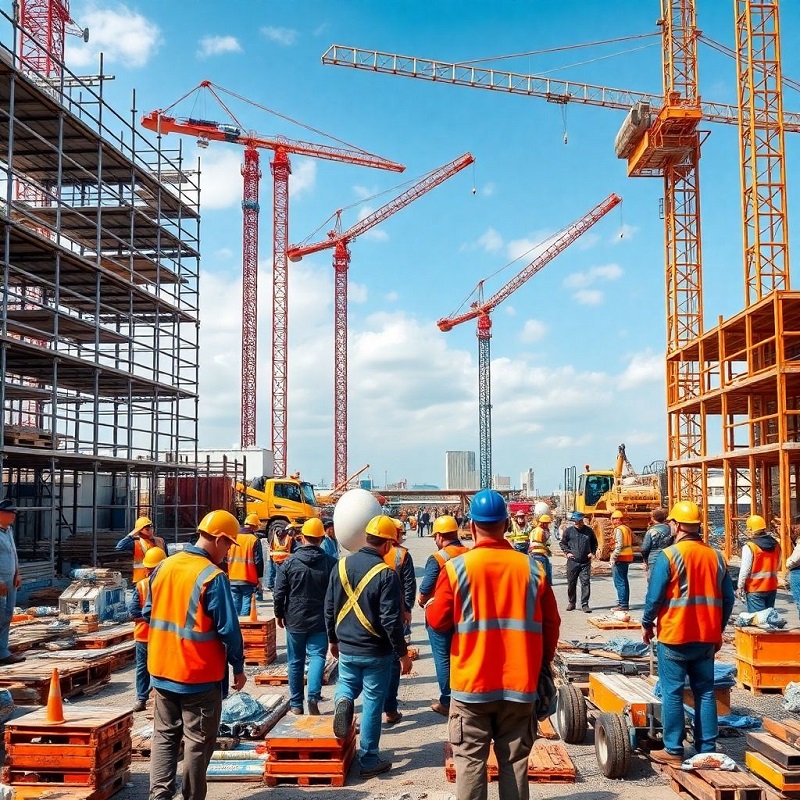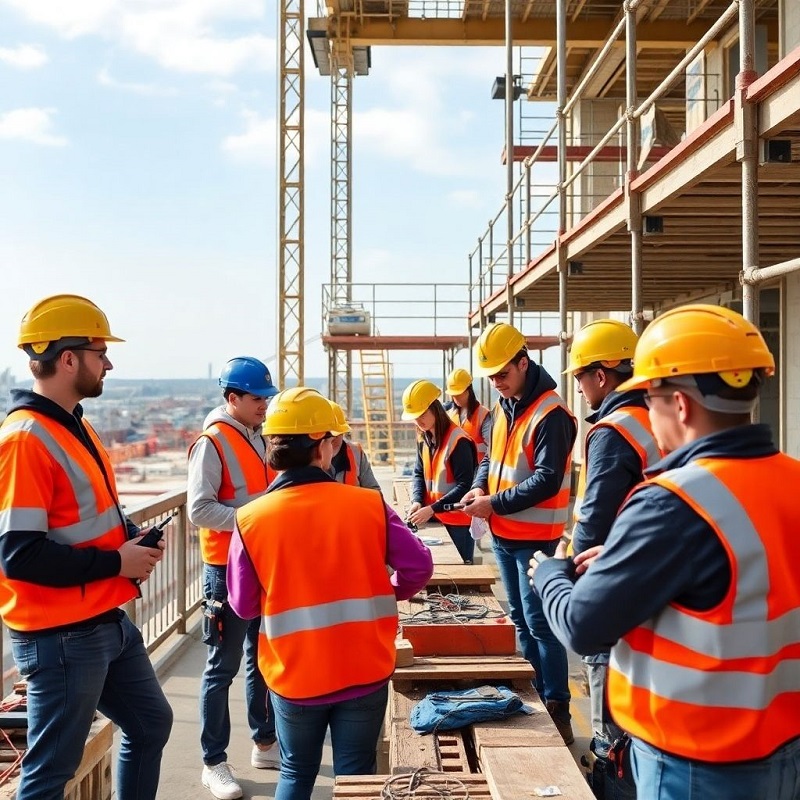Key Points
- Construction sites come in different types – residential, commercial and industrial.
- Safety is key on a construction site – protective gear and proper handling of hazardous materials.
- 3D printing and modular building are changing the way we build.
- Heavy machinery is important but safety protocols must be followed to avoid accidents.
- Weather can affect construction work – extreme heat, rain or cold requires specific precautions.
- Permits and Regulations on a Construction Site.
A construction site, a bustling hub where various trades converge to shape the structures that define our communities, is not without its challenges. Safety, a paramount concern, is a thread that runs through every aspect of a construction site, from the hazards workers face to the innovations driving improvements. In this article, we will delve into the multifaceted nature of a construction site, the safety challenges it presents, and the strides being made to enhance safety and efficiency.
What is a Construction Site?
A construction site is an area where workers and equipment come together to build, modify or repair structures. It’s a busy place with workers, machines and materials all working together to build structures. Sites come in all shapes and sizes – from big skyscrapers to small homes. They’re dynamic environments with work happening from planning and foundation to finishes and inspections. Every site is unique but they all have one thing in common – to build something functional and safe.
Construction Sites
Construction sites, often associated with the construction of houses or skyscrapers, actually encompass a wide range of projects. From roads and bridges to schools and hospitals, each type of construction site operates under its own set of rules and regulations. Whether it’s a small home renovation or a large-scale infrastructure project, construction sites are where ideas take shape and become reality.
Construction sites can vary depending on the project. Here are some examples:
- Residential Sites
Residential sites are smaller sites used for building and renovating houses, apartments, and other living spaces. They are located within neighborhoods or residential areas.
- Commercial Sites
These are for building structures for business or commerce, like offices, shopping centers, hotels and restaurants. These are bigger than residential sites and can take months or years to finish.
- Industrial Sites
This includes construction of factories, power plants and warehouses. Industrial sites are complex and require specialized equipment and heavy machinery to build facilities for production and manufacturing.
- Infrastructure Sites
Infrastructure sites are for public projects, such as roads, bridges, tunnels, and airports. These are government-funded and aim to improve transportation and public utility services.
- Environmental Sites
With a focus on sustainability, these sites include wind farms, solar energy plants and water treatment facilities. Requires careful planning to balance environmental impact with construction needs.
Safety First: Construction Hazards
Personal Protective Equipment
Safety is key on construction sites. Workers need to wear the right gear to protect themselves from everything. Personal protective equipment, or PPE, includes hard hats, gloves, and safety glasses. These are crucial because they prevent falling objects and other hazards that can pop up on site.
Hazardous Materials Handling
Construction sites deal with hazardous materials, which, if not handled correctly, can be deadly. Workers need to be trained to identify these materials and know how to handle them safely. This means using the right tools and following procedures to avoid accidents. It’s all about keeping everyone safe while getting the job done.
Emergency Procedures
Even with stringent safety measures in place, emergencies can still occur on a construction site. This is why clear and effective emergency procedures are crucial. Workers must be well-versed in these procedures, knowing where the first aid kits are located and how to contact emergency services. Being prepared can make a significant difference in maintaining safety on site.
Building the Future: New Construction Techniques
3D Printing
3D printing is changing the construction game. This technology allows builders to build layer by layer, which saves time and money. Imagine a giant printer that can print walls and even entire homes! It’s not just about speed; it’s also about less waste and more design freedom.
Modular Building Systems
Modular building systems are like building with blocks. Instead of building everything on site, parts of the building are built in a factory and assembled on-site. This can speed up the process and make it safer for workers. With everything pre-built there’s less time spent in potentially hazardous environments, which is a big win for safety.
Sustainable Materials
Using sustainable materials is the new big thing in construction. Builders are looking for ways to use eco-friendly options that are better for the planet. This includes recycled materials and energy efficient designs that reduce the carbon footprint of buildings. By focusing on sustainability, the construction industry is not just building structures but also the environment for future generations.
Heavy Machinery: The Heart of Construction
Heavy machinery is like muscle that gets the job done on a construction site. These powerful machines are necessary for moving materials, digging, and lifting heavy loads. From cranes that reach high into the air to excavators that dig deep into the ground, each piece of equipment plays a vital role in keeping projects on track.
Running a crane is no easy task. It takes skilled operators who can handle these big machines with precision. They need to be aware of their surroundings and follow strict safety protocols to avoid accidents. Excavators are the workhorses of the site. They can dig trenches and move earth with ease. Keeping these machines in top condition is key, which is why maintenance is a must. Without proper care, even the best equipment can break down and cause delays and safety risks.
In the construction world, heavy machinery isn’t just helpful; it’s necessary for getting the job done right.
Key people on site
When it comes to a site, there are a few key people who keep everything ticking over. The project manager is the ship’s captain, steering the team towards success by ensuring everyone knows what they need to do and by when. They’re the ones who see the big picture, coordinate between different teams, and keep the project on track.
Then there’s the site engineer, who is the technical expert. They’re the ones you go to for all the technical questions. They ensure the plans are followed and everything is built to spec. Attention to detail is key to avoiding costly mistakes.
Then there’s the construction foreman, who’s the eyes and ears on the ground. They supervise the workers, making sure everyone is working safely and efficiently. It’s a tough job, but they’re the ones who keep the morale high and the work flowing.
Finally, we have the general and skilled workers. These are the backbone of the site, doing the actual work that brings the project to life. Whether they’re pouring concrete or fixing fixtures, their skills and hard work make the vision a reality. Without these key people, a site would be a disaster!
Weathering the Storm: Weather Conditions
When it comes to construction, weather can be a real show-stopper. Rain, snow, or extreme heat can mess with the best laid plans. Workers need to be prepared for whatever Mother Nature throws at them.
Working in Extreme Heat
Working in the sun is tough. Make sure to stay hydrated and take breaks in the shade. Heat exhaustion is no joke and staying cool is key to staying safe on site.
Rainy Day Issues
Rain makes things slippery and dangerous. When it pours, sites can turn into mud baths, making it hard to move equipment and materials. Workers need to be extra careful to avoid slips and falls; sometimes they just have to wait until the storm passes.
Cold Weather Precautions
When it gets cold, construction doesn’t stop, but it does require some extra precautions. Workers need to dress in layers to stay warm and avoid frostbite. Equipment can freeze, so make sure to check everything before you start the day. Keeping everyone safe and warm is key.
Blueprints to Reality: The Planning Process
Reading Blueprints
When it comes to building, blueprints are the map of the whole project. They show where everything goes, from walls to windows. You gotta read these plans right because misreading something can cause big problems down the line. Everyone on the team has to be on the same page so the building turns out right.
Architects and Engineers
Architects and engineers are the brains behind the design. They work together to create plans that are not only beautiful but also safe and functional. They think about how the building will be used and what materials will work. They also have to make sure everything meets local building codes. Without them, projects can go off the rails.
Changing Plans On-the-Fly
Sometimes, things don’t go as planned on a job site. Weather can change, materials don’t show up on time, or unexpected issues pop up. That’s when the ability to adapt becomes super important. Teams need to be flexible and able to make changes to the plans. Thinking on your feet can save a project from delays and keep everything moving smoothly.
Tech on Construction Site: Going Digital
Drones for Site Surveys
Drones are changing the game on job sites. They can fly over hard-to-reach areas and give a bird’ s-eye view of the project, so teams can see what’s going on without putting anyone in harm’s way. Using drones saves time and keeps workers safe.
Construction Management Software
Managing a construction project is like juggling flaming torches, but with the right software, it’s a lot easier. These tools help teams keep track of tasks, budgets, and schedules all in one place. It’s like having a super organizer who makes sure everyone is on the same page. Staying organized is key to getting projects done on time.
Wearable Tech for Safety
Wearable technology is stepping up safety on job sites. From smart helmets that can detect hazards to vests that monitor workers’ health, these gadgets are making a big impact. They keep everyone safe and sound while they work. With these tools, workers can focus on their tasks without worrying as much about the dangers.
Green Construction: Going Green
Building green is not just a trend; it’s a must. Eco-friendly construction practices help the planet and save money in the long run. Using recycled materials and energy-efficient systems is a great way to reduce waste and lower energy bills. Incorporating renewable energy sources like solar panels can make a big impact on how much energy a building uses.
Construction waste management is another area where companies can make a difference. By recycling and planning for waste reduction, they can keep more stuff out of landfills. It’s all about a sustainable future one building at a time!
Training and Development: Learning on the Job
In construction, training is key to ensuring everyone knows what they’re doing. On-the-job training programs are super important because they let workers learn while they work. This hands-on experience helps them pick up skills that are hard to teach in a classroom.
Many companies are partnering with schools to create apprenticeship programs. These partnerships bring in fresh talent and ensure new workers are ready for the job. Offering good pay and benefits can really help keep skilled workers around, especially when there’s a labor shortage.
Another big part of training is making sure everyone knows about safety. Regular safety meetings and training sessions keep workers aware of hazards. It’s all about creating a culture where safety comes first so everyone can go home safely at the end of the day.
Companies also need to keep up with new technology in this fast-paced world. Training workers on the latest tools and techniques can make a big difference to a project. Embracing new tech not only boosts productivity but also makes the job more attractive to younger workers who are used to using gadgets and software in their daily lives.
Permits and Regulations on a Construction Site
Construction sites are heavily regulated for safety, environmental and local laws. Here’s what you’ll need:
Building Permits: Before building, comply with zoning and safety standards.
Environmental Permits: Sites must comply with environmental regulations to reduce pollution and protect local wildlife.
Safety Permits: Cranes and scaffolding must be inspected and certified for safety.
Work Permits: In some areas, workers may need to be certified to operate certain machinery or do certain tasks.
Not complying can result in big fines or project delays, so compliance is key to the project’s success.
FAQs
- What is a construction site?
A construction site is where a project is being built, whether a building, road or other structure. It’s a controlled environment for all the steps of construction.
- What are the main safety measures on a construction site?
Wearing PPE, regular training, signage for hazardous areas and daily inspections to identify and mitigate risks.
- How is technology changing construction sites?
Drones, 3D printing and wearable devices improve site efficiency, accuracy and safety so projects run smoother and safer.
- Why are green practices important on construction sites?
Green practices reduce environmental impact by conserving resources and reducing pollution so the industry can be more sustainable.
- What jobs are on a construction site?
Labourers and foremen, engineers, project managers, and safety officers all work together to get the job done.






